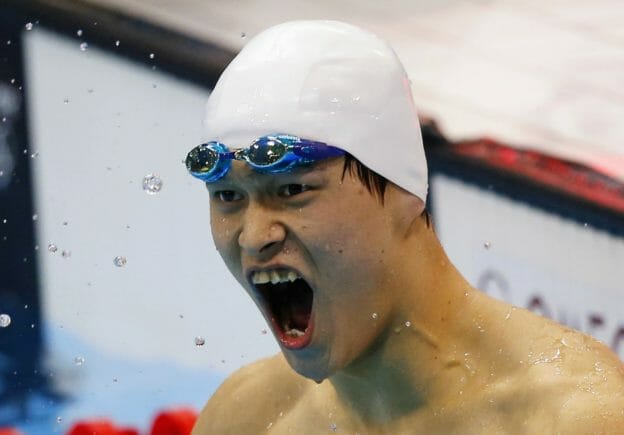While Sun Yang is not the only great 1500 freestyler to use a hip-driven freestyle, he is the fastest one to do so, holding the world record at 14:31.02. With a stroke rate of around 61 strokes per minute, Sun Yang seems to be swimming effortlessly through this distance. Besides the fact that he finishes the final 50 meters of the 1500 in a time that would be considered reasonably good in the second 50 of a hundred-meter freestyle, and significantly faster than anyone else in history, there are three very unique techniques that he uses during the majority of his race.
- The Flick Kick
This technique is perhaps the most unusual, as I have not seen this replicated by any other elite swimmer. Rather than the traditional 6 beat kick where every third down kick is more forceful and timed with the opposite hand entry (what I call the surge kick), Sun Yang does a very fast ‘karate-type’ down kick with very little knee bend. This kicking technique likely produces more surge (distance per stroke) than the traditional harder down kick and certainly causes less frontal drag by requiring less knee bend. To implement this technique, the swimmer must have extreme plantar flexibility in the feet. In between the flick kicks, after the right-hand entry, he also adds two relatively normal kicks. Yet after the left-hand entry, during the breath, he doesn’t kick at all, perhaps saving his energy for a more robust flick kick after the breath. The result is actually a 4-beat kick, with two strong unusual surge flick kicks and two normal kicks.
- The Breathing Pattern
At a stroke rate of 61, breathing every cycle would create a respiratory rate of about 30 breaths per minute. Since the physiologically ideal respiratory rate of an athlete with prolonged intense exertion of 15 minutes is around 50 breaths per minute, neither giving up that much oxygen nor ridding the body of CO2 with a lower respiratory rate of 30 is a good idea. Sun Yang compensates for his low stroke rate by taking 3 or sometimes more consecutive breaths in a row going into and out of nearly all turns. Occasionally, later in the race, he will do the same in the middle of the pool. While this may be a little easier to do at his slower stroke rate, those extra breaths help keep his pH more neutral and enable him to use an exceptional sprint at the finish.
- The Hand Entry
With the slower stroke rate of hip-driven freestyle, the hands are held in front for a longer period of time than with shoulder-driven or a hybrid freestyle technique. Since the hands are moving forward at this point and contribute to frontal drag, the positioning of the hands, and particularly with the hip-driven or hybrid freestyle technique, is very important. Sung Yang does something I have seen almost no other elite swimmer do, and that is turn his hand sideways after entry so that the little finger is down as he glides forward prior to initiating the lift phase of the pull by pressing down with the palm of his hand. Michael Phelps used this hand entry technique to a lesser degree in the 800 free relay of the Rio Olympic Games of 2016. Sun Yang uses this hand entry technique more with the right hand than with the left, but this unusual hand position may have the effect of reducing frontal drag. Next time I am in Florida, we plan to test this vertical hand position against the traditional palm down hand position, using our Propulsion/Drag Meter, to see if there is a measurable difference in frontal drag between these two hand entry techniques.
In addition to the three unique or unusual swimming techniques mentioned above, Sun Yang also uses several other desirable freestyle techniques that enable him to swim fast at such a slow stroke rate:
- He submerges his head completely after each breath (reduces frontal drag)
- He draws his elbows very high on the arm recovery (increases body rotation or coupling effect for greater propulsion)
- He pulls with an extremely high elbow motion (reduces frontal drag)
- He releases air bubbles under water through his nose after each breath which envelope his under body (reduces frontal drag)
The 1500 m freestyle for men offers a wider variety of swimming techniques that seem to work well than in any other freestyle event. In the upcoming world championships, it will be interesting to see (if Sun Yang competes in the 1500) how his efficient, 61 SR freestyle compares to the fast 96 SR, hybrid freestyle of Gregorio Paltrinieri and other swimmers with stroke rates in between.
This week on our Race Club subscription in Lanes 1-4 (complementary) , you will find a great webisode showing how freestyler’s release air bubbles through their noses after each breath. We also share our drag tests using this technique compared to holding your breath. You will be surprised at the results.
Yours in swimming,
Gary Sr.
How To Breathe: https://theraceclub.com/video/how-to-breath-in-freestyle/
Head Position: https://theraceclub.com/
Coupling: https://theraceclub.com/

